Abstract
The detection of aliphatic and aromatic biogenic amines (BAs) is important in food spoilage, environmental monitoring, and disease diagnosis and treatment. Existing fluorescent probes predominantly detect aliphatic BAs with single signal variation and low sensitivity, impairing the adaptability of discriminative sensing platforms. Herein, we present a visual chemosensor (galactose-functionalized pyrrolopyrrole aza-BODIPY, PPAB-Gal) that simultaneously detects eight aliphatic and aromatic BAs in a real-time and intuitive way based on their unique electronic and structural features. Our findings reveal that the dual colorimetric and ratiometric emission changes are rapidly produced in presence of eight BAs through a noncovalent interaction (π–π stacking and hydrogen bond)-assisted chromophore reaction. Specifically, other lone-pair electrons containing compounds, such as secondary amines, tertiary amines, NH3, and thiol, fail to exhibit these changes. As a result, superior sensing performances with distinctly dual signals (Δλab = 130 nm, Δλem = 150 nm), a low LOD (~25 nM), and fast response time (<2 min) were obtained. Based on these advantages, a qualitative and smartphone-assisted sensing platform with a PPAB-Gal-loaded TLC plate is developed for visual detection of putrescine and cadaverine vapor. More importantly, we construct a connection between a standard quantitative index for the TVBN value and fluorescence signals to quantitatively determine the freshness of tuna and shrimp, and the method is facile and convenient for real-time and on-site detection in practical application. Furthermore, since the overexpressed spermine is an important biomarker of cancer diagnosis and treatment, PPAB-Gal NPs can be used to ratiometrically image spermine in living cells. This work provides a promising sensing method for BAs with a novel fluorescent material in food safety fields and biomedical assays.
1. Introduction
The important food sources in our lives, such as cheese, fish, shrimp, meat, or dairy products, are rich in proteins, lipids and vitamins [1,2]. Nevertheless, they are easily spoiled and generate biogenic amines (BAs), where proteins are decomposed by endogenous enzymes and pathogenic microorganisms [3]. Both typical aliphatic BAs (spermine, spermidine, putrescine, and cadaverine) and aromatic BAs (tyramine, histamine, 2-phenylethylamine, and tryptamine) are released. Excessive amounts of BAs are toxic and foul-smelling, posing a serious threat to the environment and public health. In particular, high levels of histamine in seafood are responsible for scombroid poisoning [4,5,6]. Excessive concentrations of 2-phenylethylamine induce high blood pressure, neurotoxicity, and allergies [7]. Overdoses of tryptamine cause hallucinations, shock, or sudden death. Meanwhile, the inhibitory effects of putrescine and cadaverine on histamine-related enzymes have been demonstrated [8], worsening the painful sensation. Among them, tyramine and histamine are the most common intoxication sources. The greatest risk from BAs derives from their accumulation in certain foods [9,10,11,12,13]. The guidance levels for histamine, tryptamine, and 2-phenylethylamine are 50, 100–800, and 30 mg/kg, respectively, in aquatic products as established by the FDA [14,15,16]. On the other hand, spermine serves as an essential modulator of multiple intracellular processes, including cellular proliferation, progression, viability, protein synthesis, and gene expression [17]. The high level of spermine is associated with cancer as well as gastrointestinal and immunological diseases. Therefore, developing sensing materials capable of simultaneous detecting of aliphatic and aromatic BAs is vital and urgent for human health and food quality.
Traditional BA analysis methods include HPLC, LC–MS, GC–MS, ELISAs, sensor arrays, electrophoresis, and electronic nose, etc. They can accurately determinate BA contents; however, some drawbacks such as time-consuming and complex operation procedures, complicated and expensive instruments, and the requirement of professional personnel are encountered. It is noteworthy that chemical reaction-based fluorescent probes for BA detection have remarkable advantages due to the high selectivity, fast response, simple operation, and excellent sensitivity. Several sensing mechanisms including nucleophilic addition, chromophore reaction, aza-Michael addition, condensation reaction, formation of Schiff bases, and ester aminolysis reaction have been developed [18,19,20,21,22,23,24]. Unfortunately, these fluorescent probes just work on aliphatic BAs and fail to respond to aromatic BAs due to their large steric hindrance of the aromatic group and reduced nucleophilicity of the amine group [25,26]. At present, the detection of aromatic BAs mainly relies on instrumental methods, fluorescent covalent organic frameworks, metal organic frameworks, and fluorescent quantum dots based on acid-base or host-guest interactions [27,28,29,30]. Therefore, several issues are urgently needed to be solved in the field of BA detection. (1) The majority of chemical reaction-based fluorescent probes for aliphatic BA detection still have shortcomings, such as a sluggish reaction rate, a pure organic solvent detection system, strong background fluorescence, and inferior sensitivity. (2) Developing a new strategy to achieve aromatic BA detection is required. It remains extremely challenging to exploit a chemical reaction-based fluorescent probe that can simultaneously detect aliphatic and aromatic BAs.
The largely conjugated pyrrolopyrrole aza-BODIPY (PPAB) fluorophore has intense absorption and fluorescence in the NIR region. Our group is the first to use PPAB to detect aliphatic BAs through a chromophore reaction mechanism [31,32,33,34]. With this objective and combined with our research interest, we constructed a fluorescent probe PPAB-Gal using PPAB as a fluorophore and recognition site linked to 1,2,3-triazole and a galactose group as the reaction accelerator (Scheme 1). The noncovalent interactions (hydrogen bond and π–π interaction, etc.) between PPAB-Gal and aliphatic/aromatic BAs would bring BAs to the proximity of the PPAB-Gal. As a result, subsequent intramolecular chromophore reaction between them would be highly accelerated, yielding superior sensing performance for aliphatic BAs and simultaneously detecting aromatic BAs with excellent sensitivity. Several advantages have been shown as follows. (1) Simultaneous detection of 8 BAs using a single reaction-based fluorescent probe in 20% DMSO /H2O (4/1, v/v) was achieved for the first time. (2) The superior sensing performance such as distinctly dual signals (Δλab = 130 nm, Δλem = 150 nm) with ratiometric fluorescence for naked eye detection, low LOD (down to 25 nM) and fast response time (<2 min) were successfully obtained. (3) More importantly, by integrating PPAB-Gal-loaded TLC plate with smart phone-adaptable RGB color (red, green, blue) mode analysis, quantitative and reliable monitoring aquatic product freshness were further realized by direct visualization. (4) PPAB-Gal NPs also offered bioimaging application for detection spermine in live cells.
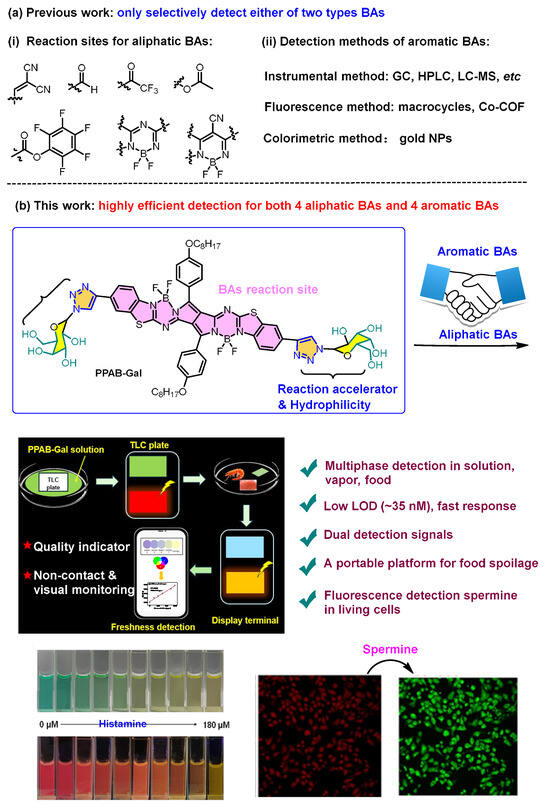
Scheme 1.
(a) Previous work for BAs sensing. (b) The design strategy of fluorescent probe (PPAB-Gal) in this work for aliphatic and aromatic BAs detection.
2. Experimental Section
2.1. Instruments and Materials
The common organic solvents and other chemicals were commercially available without further purification. 8 BAs including spermine (Spm), spermidine (Spd), putrescine (Put), cadaverine (Cad), tyramine (Tyr), histamine (His), 2-phenylethylamine (Phe) and tryptamine (Try) were obtained from Bide Pharmatech Ltd. (Shanghai, China). All optical spectra were recorded at 25 °C. For NMR, UV-vis and fluorescence measurement, the liquid samples were used. Bruker Avance III 400 MHz (Bruker, Rheinstetten, Germany) was used to provide 1H and 13C NMR spectra. Hitachi U-3900H spectrophotometer and Hitachi F-4500 spectrophotometer were utilized to supply the absorption and fluorescence spectra, respectively. MALDI-TOF mass and FT-IR spectra were recorded on a Autoflex speed TOF/TOF mass spectrometer (Bruker, Rheinstetten, Germany) and a Brucker VERTEX 80 V FTIR spectrometer (Brucker, Rheinstetten, Germany), respectively. The total volatile base nitrogen (TVBN) content is a key factor in measuring meat quality, which is determined with a Kjeldahl nitrogen detector (BUCHI K-375, Labortechnik, AG, Swiss).
Compounds 1, 3 and PPAB-1 were synthesized according to previous work [35,36].
To gain a deep understanding of the noncovalent interactions (π–π stacking, and hydrogen bond) relationship between PPAB-Gal and aromatic BAs, the computational platforms such as Gaussian 16, Multiwfn software, VMD program and the independent gradient model based on Hirshfeld partition (IGMH) were utilized.
2.2. Synthesis of Compound PPAB-2
PPAB-1 (100.00 mg, 0.08 mmol) and K2CO3 solid (29.00 mg, 0.21 mmol) were added to the mixture of CH2Cl2/MeOH (2/1, v/v) under nitrogen. After stirring at room temperature for 30 min. The crude product was separated with silica gel column chromatography to yield PPAB-2 as green solid (61.00 mg, 70%). 1H NMR (400 MHz, CDCl3) δ 8.98 (d, J = 2.2 Hz, 2H), 8.37 (d, J = 11.1 Hz, 4H), 7.81 (dd, J = 8.7, 2.0 Hz, 2H), 7.31 (d, J = 8.8 Hz, 2H), 6.99 (d, J = 8.8 Hz, 2H), 4.15 (t, J = 6.5 Hz, 4H), 3.26 (s, 2H), 1.90 (p, J = 6.7 Hz, 4H), 1.47–1.24 (m, 20H), 0.91 (t, J = 6.4 Hz, 6H). HRMS (ESI): m/z [M+H]+ calcd for C48H48B2Br2F4N6O2: 998.2457, found: 998.2401.
2.3. Synthesis of Compound PPAB-OAc
PPAB-2 (200.00 mg, 0.20 mmol) and compound 3 (300.00 mg, 0.80 mmol), CuSO4·H2O (100.00 mg, 0.40 mmol) and sodium ascorbate (100.00 mg, 0.50 mmol) were added to the mixture of THF/H2O (20.00 mL/8.00 mL). After stirring at room temperature for 7 h, water was added. The reaction mixture was extracted three times with dichloromethane. The organic layer solution was collected, and dichloromethane was removed under reduced pressure. The crude product was separated with silica gel column chromatography to yield PPAB-OAc as green solid (348.00 mg, 25%). 1H NMR (400 MHz, CDCl3) δ 9.01 (d, J = 2.2 Hz, 2H), 8.67 (d, J = 2.2 Hz, 2H), 8.41 (m, 4H), 8.15 (s, 2H), 7.46 (d, J = 8.8 Hz, 2H), 7.03 (d, J = 8.9 Hz, 2H), 5.89 (d, J = 9.2 Hz, 2H), 5.63–5.52 (m, 4H), 5.29 (dd, J = 10.3, 3.3 Hz, 2H), 4.32–4.13 (m, 10H), 2.28 (s, 6H), 2.05 (d, J = 10.0 Hz, 12H), 1.93 (s, 6H), 1.55 (q, J = 7.3 Hz, 4H), 1.47–1.17 (m, 20H), 0.94–0.88 (m, 6H). HRMS (ESI): m/z [M+H]+ calcd for C76H86B2Br2F4N12O20: 1745.4583, found 1745.4657.
2.4. Synthesis of Compound PPAB-Gal
PPAB-OAc (30.00 mg, 0.02 mmol) and K2CO3 (5.88 mg, 0.04 mmol) was added to dichloromethane/MeOH (9.00 mL/3.00 mL). After stirring for 4 h, green solid was presented. After filtering, the resulting solid was washed with dichloromethane to obtain green solid PPAB-Gal (19.40 mg, 80%). 1H NMR (400 MHz, DMSO-d6) δ 9.21 (s, 2H), 8.93 (s, 2H), 8.82 (d, J = 2.2 Hz, 2H), 8.66 (dd, J = 8.8, 2.0 Hz, 2H), 8.47 (dd, J = 8.7, 2.3 Hz, 2H), 7.48 (d, J = 8.9 Hz, 2H), 7.36 (d, J = 8.9 Hz, 2H), 5.58 (d, J = 9.1 Hz, 2H), 5.32 (d, J = 5.8 Hz, 2H), 5.11 (d, J = 5.5 Hz, 2H), 4.79–4.70 (m, 4H), 4.25 (t, J = 6.4 Hz, 4H), 4.13–4.03 (m, 2H), 3.81 (q, J = 6.2, 5.6 Hz, 4H), 3.58 (m, 6H), 1.83 (q, J = 6.8 Hz, 4H), 1.45–1.22 (m, 20H), 0.92–0.86 (m, 6H). HRMS (ESI): m/z [M+H]+ calcd for C60H70B2Br2F4N12O12: 1408.7136, found: 1408.8127.
2.5. Spectroscopic Measurements
PPAB-Gal was dissolved in DMSO to give the stock solution (0.1 mM), which was diluted with water to produce test solution (10 μM) in DMSO/H2O (4/1, v/v). Tryptamine stock solution (0.1 M) was prepared in ethanol, and the remaining seven BAs stock solution (0.1 M) were prepared in H2O. When PPAB-Gal test solution was mixed with BAs solution for desired time, the absorption and fluorescence spectral measurement was carried out in a 2 mL quartz cell with an optical path length of 1 cm at room temperature.
2.6. Fabrication of PPAB-Gal-Loaded TLC Plates
PPAB-Gal solution (1 mM in DMSO) was prepared. TLC plates were dried at oven at 105 °C for 30 min to remove the possibly remaining water. The dried TLC plates were soaked into PPAB-Gal solution for 2 min. Then, TLC plates were taken out and dried in the oven. The same procedure was repeated three times to prepare PPAB-Gal TLC plates.
2.7. Visual Detection of Shrimp or Tuna Freshness with PPAB-Gal-Loaded TLC Plate
Freshly slaughtered samples (shrimp and tuna) were bought from local supermarket (Guangzhou, China). The samples were placed in glass Petri dishes. The PPAB-Gal-loaded TLC plates were attached to the inner cover of another Petri dishes. The two Petri dishes were sealed with tape. These Petri dishes with real samples were kept at 25 or 4 °C for different storage time, respectively. Then, the photos were taken under daylight or 365 nm UV lamp by smartphone. The smartphone-adaptable RGB color APP was used to output red, green, blue values.
2.8. Determination of TVBN Content in Shrimp or Tuna
On the base of Standard GB 5009.228-2016 (China) [37], TVBN content in real samples was measured as a control index to evaluate the meat freshness. The shrimp or tuna was purchased from local supermarket. The samples (1 g) were cut into small pieces and 50 mL distilled water was added. After shaking for 30 min and filtration, MgO (1 g) was added. The 25 mL resulting extraction solution was selected as experimental samples. Meanwhile, 50 mL (NH4)2SO4 aqueous solution (0.004 g/mL) was used as a control. TVN value was measure by steam distillation through Kjeldahl distillation unit. The resulting distillate was neutralized by H3BO3 (30 mL, 20 g/L), followed by titration with HCl (0.1 mol/L).
2.9. Preparation of PPAB-Gal NPs
A modified co-precipitation method was used to prepare PPAB-Gal NPs. In a typical experiment, 2 mg of PPAB-Gal and 5 mg of DSPE-PEG2000 were dissolved in 1 mL THF solution, and the mixture was injected into 5 mL deionized water. Then the mixture was evaporated to remove THF completely on a rotary evaporator at 40 °C. The resulting mixture was cooled to room temperature. The obtained solution of PPAB-Gal NPs was filtered by a 0.22 μm filter to discard big aggregates and stored at 4 °C for further use.
2.10. Cell Culture
Cells were cultured in high-glucose Dulbecco’s Modified Eagle’s Medium (H-DMEM) containing 10% fetal bovine serum (FBS) and 1% penicillin streptomycin at 37 °C in a humidified environment containing 5% CO2. Before the experiment, the cells were precultured until confluence was reached.
2.11. Cell Imaging
HeLa cells were seeded in the 12-well plate and cultured in H-DMEM with 10% FBS at 37 °C in a humidified environment containing 5% CO2. After 80% confluence, the medium was removed and the adherent cells were rinsed twice with 1 × PBS. Cells were incubated with PPAB-Gal NPs (50 μM) in absence or preence of spermine (100 μM) for 4 h. After washing the culture dishes three times with PBS, fluorescence imaging experiments were carried out on a LSM710 confocal microscope (Carl Zeiss, Germany).
3. Results and Discussion
3.1. Characterization and Spectra Performance of PPAB-Gal
In Scheme 2, the condensation reaction between trimethylsilicon-alkynyl aminopyridine (compound 1) and diketopyrrolopyrrole (compound 2) and a subsequent boron complexation generated PPAB-1. After desilylation reaction of PPAB-1 with K2CO3, terminal alkyne containing PPAB-2 was obtained [35]. The following Cu(I)-catalyzed azide–alkyne click cycloaddition with acetylgalactose-azide (compound 3) gave PPAB-OAc. The deprotection of PPAB-OAc in presence of base generated galactose functionalized PPAB-Gal. The chemical structures of these compounds were characterized using MALDI-TOF and NMR spectroscopy (Figures S1–S6). The n-octanol/water partition coefficient (Clog P) values were used to evaluate their hydrophilicity. The value of 13.268, 12.928 and 8.641 for PPAB-2, PPAB-OAc and PPAB-Gal was found, respectively, indicating their hydrophilicity was gradually improved by introduction of 1,2,3-triazole and galactose groups to PPAB core. Meanwhile, the presence of galactose made PPAB-Gal soluble in polar solvents (acetone, MeOH, EtOH, DMSO, DMF).
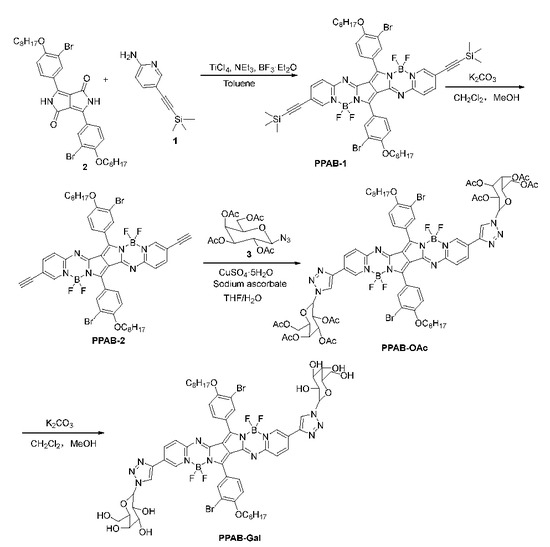
Scheme 2.
The synthetic routes of PPAB-Gal.
As shown in Figure S7a,b, a slightly gradual red-shift from 668, 673 and 675 nm for absorption maximum as well as 686, 692 and 698 nm for emission maximum was shown for PPAB-2, PPAB-OAc and PPAB-Gal in CH2Cl2, respectively. The results suggested that conjugation of galactose via 1,2,3-triazoles linker did not significantly alter the spectral properties of PPAB dyes. PPAB-2 and PPAB-OAc showed solvent polarity independent absorption and emission maximum (Figure S8a–d and Table S1). Interestingly, PPAB-Gal exhibited a slightly solvent-dependent absorption and emission behavior due to the presence of polar galactose groups (Figure S8e,f). The changes of absorption maximum from 660 to 676 nm as well as emission maximum from 679 to 698 nm from MeOH to DMSO were observed. It is possible the galactose of PPAB-Gal was susceptible to solvent polarity, making the spectral properties different. The density functional theory (DFT) calculations showed that the energy gaps (Eg) of 2.027, 2.010 and 2.032 eV for PPAB-2, PPAB-OAc and PPAB-Gal, respectively (Figure S9). The electron densities were mainly distributed on the PPAB core for three PPAB dyes, which was consistent with their minor solvatochromic behavior.
The aggregation behavior of PPAB-2, PPAB-OAc and PPAB-Gal were investigated. In DMSO, PPAB-2 showed a strong shoulder absorption peak at 615/669 nm. Upon adding 15% water volumetric factions (fw), the absorption intensity significantly decayed, and the spectra became broader. The red-shifted shoulder at 627/679 nm was observed when fw increased to 90% (Figure S7c), indicative of formation of J-aggregates. For PPAB-OAc, similar absorption decay and broadening was shown when fw increased from 0 to 90% (Figure S7e). These observations indicated that PPAB-2 and PPAB-OAc with planar rigid π-conjugated structures exhibited a “head-to-tail” orientation and parallel sliding structure to form J-aggregates. For PPAB-Gal, the presence of 15% fw didn’t induce the change of absorption spectrum. If fw increased to 90%, the original absorption shoulder at 619/676 nm was blue-shifted to 596 /671 nm, indicating the H-aggregates were formed (Figure S7g). This phenomenon can be ascribed to the presence of hydrophilic galactose of PPAB-Gal. It’s possible that the multiple H-bonds between galactoses potentially increase “face-to-face” stacks among PPAB-Gal aggregated state, thereby facilitating H-aggregates formation. Some studies revealed typical non-covalent bonds contributed to the self-assembly process [38].
In the emission spectra, PPAB-2 showed more obvious aggregation-caused quenching (ACQ) effect than PPAB-OAc in presence of water. Upon addition of 15% fw, the fluorescence quenching rate of 99% and 70% was found for PPAB-2 and PPAB-OAc, respectively (Figure S7d,f). On the contrary, PPAB-Gal showed a certain anti-aggregation effect. There were no fluorescence quenching phenomena when fw was lower than 15%. However, the emission intensity at 698 nm was largely weakened as fw increased from 15 to 30% (Figure S7h). Then the fluorescence was completely disappeared by adding more water. This phenomenon was agreement with their Clog P values, where more hydrophobic PPAB-2 and PPAB-OAc resulted in a higher degree of aggregation and drastic fluorescence quenching in an aqueous solution. All these results indicated the presence of hydrophilic galactose played a significant role in adjusting photophysical properties and the formation of H-aggregates of PPAB-Gal.
3.2. Spectral Response of PPAB-Gal Towards 8 BAs
Among aromatic BAs, high intake of toxic His could cause poisoning and allergic reactions. His was used as a typical aromatic BA model to test the sensing practicability of PPAB-Gal in DMSO/H2O (4/1, v/v). As indicated in Figure 1a, time-dependent absorption spectra of PPAB-Gal in presence of His was measured. Delightedly, the characteristic shoulder peak at 619/673 nm in NIR region showed a rapid drop along with the increment of reaction time. Moreover, a new absorption shoulder band at 470/483 nm gradually emerged, indicating less conjugated new compounds were formed. The aromatic BAs (His, Try, Tyr, Phe) and aliphatic BAs (Spd, Spm, Put, Cad) induced similar UV-vis spectra changes (Figure 1b–h,j). The reaction kinetics curves indicated that PPAB-Gal possessed high reaction rate towards eight BAs and quickly reached equilibrium within 10 min (Figure 1i). The pseudo-first-order rate constant (kobs) was calculated to be 3.151, 8.221, 8.097, 4.371, 1.127, 4.615, 7.057, and 3.893 × 10−3 s−1 for Spm, Spd, Cad, Put, His, Tyr, Try, and Phe, respectively (Figure S10). Unexpectedly, Try had higher reaction rate than Spm and Put. Among them, His showed the most sluggish reaction rate towards PPAB-Gal.
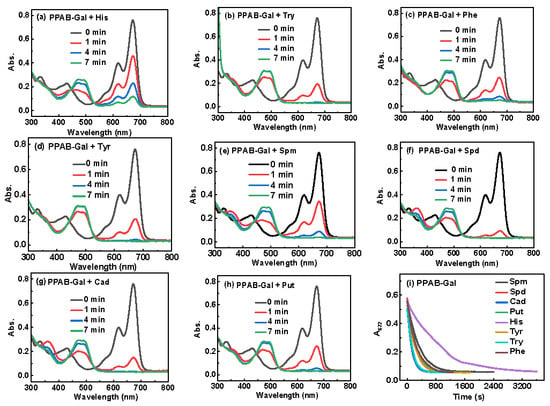

Figure 1.
Time-dependent of UV-vis spectra of PPAB-Gal (10 μM) in presence of (a) His, (b) Try, (c) Phe, (d) Tyr, (e) Spm, (f) Spd, (g) Cad, and (h) Put (200 μM) in DMSO/H2O (4/1, v/v). (i) The kinetic curves of PPAB-Gal in presence of 8 BAs. (j) The chemical structures of eight BAs.
Time-dependent fluorescence spectra of PPAB-Gal after adding aromatic BAs (His, Try, Tyr, Phe) and aliphatic BAs (Spd, Spm, Put, Cad) were shown in Figure 2a–h. Obviously, with the increment of reaction time, fluorescence intensity at 695 nm reduced dramatically, and those of a new emission peak at 545 nm enhanced gradually. As a result, I545/I695 values enhanced with the reaction time from 0 to 10 min and then kept invariable. In the case of Tyr and Try, signal changes reached maximum after 4 min. In summary, PPAB-Gal showed similar reactivity towards aliphatic BAs and aromatic BAs, mainly owing to additional noncovalent interactions (π–π stacking, and hydrogen bond, etc.).
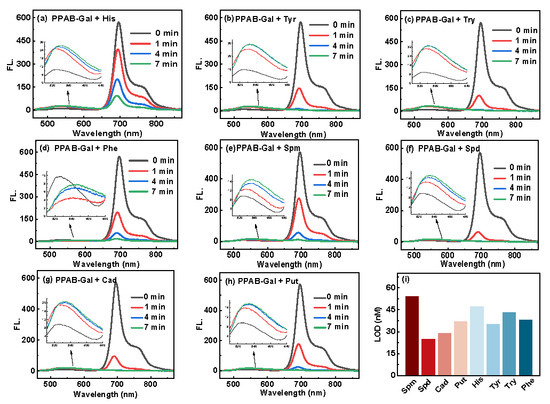
Figure 2.
Time-dependent of emission spectra of PPAB-Gal (10 μM) in presence of (a) His, (b) Tyr, (c) Try, (d) Phe, (e) Spm, (f) Spd, (g) Cad, and (h) Put (200 μM) in DMSO/H2O (4/1, v/v). (i) The LOD values of detection of 8 BAs using fluorescence method.
For the selectivity experiments, Cys, GSH, triethylamine, diethylamine, trimethylamine, and NH3 were selected. Other amines and biothiols didn’t show obvious absorption and fluorescence spectral changes of PPAB-Gal except eight BAs (Figure 3a,b). As a result, only eight BAs induced distinct A483/A672 and I545/I695 enhancement (Figure 3c,d). The selective ratiometric color change from green to faint yellow and fluorescence changes from red to orange were observed, which allowed visual detection of eight BAs (Figure 3e).
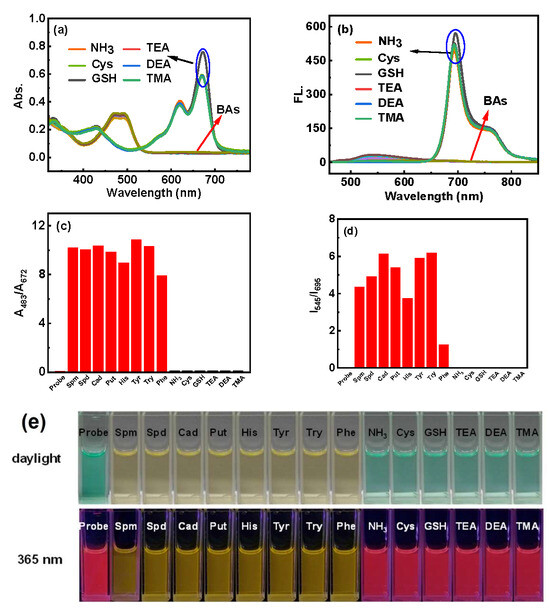
Figure 3.
The (a) UV-vis absorption, (b) emission spectra, corresponding (c) A483/A672 and (d) A545/A695 value of PPAB-Gal (10 μM) in presence of 8 BAs and other analytes (200 μM) in DMSO/H2O (4/1, v/v). (e) The photos of PPAB-Gal (10 μM) in presence of BAs and other analytes (200 μM) under daylight and 365 nm irradiation.
The absorption and emission spectra of PPAB-Gal in presence of BAs showed concentration-dependent (Figures S11 and S12). The value of A672 exhibited a good linear relationship with the BAs content at 0–180 μM. The limit of detection (LOD) of His (250 nM), Tyr (120 nM), Try (110 nM), Phe (180 nM), Spm (210 nM), Spd (120 nM), Cad (110 nM), Put (140 nM) was shown based on 3δ/k method. In addition, the good linear relationship between I695 and BAs concentration at 0–140 μM was presented with the lower LOD value of His (47 nM), Spm (54 nM), Spd (25 nM), Cad (29 nM), Put (37 nM), Tyr (35 nM), Try (43 nM), Phe (38 nM), as summarized in Figure 2i. Comparing with reported fluorescence systems for BAs sensing (Table S2), PPAB-Gal presented several significant advantages: (1) fast and efficient sensing aromatic BAs; (2) large blue shifts (Δλab = 130 nm, Δλem = 150 nm) with colorimetric and ratiometric fluorescence signals (3) simultaneous response toward 8 BAs (4 aromatic BAs and 4 aliphatic BAs) for higher sensitivity. For instance, there were some reports on fluorescent detection for His with molecularly imprinted polymer or ZnO quantum dots (LOD: 1 μM or 0.97 μM, respectively) [39,40], as well as colorimetric detection of His with gold nanoparticles (LOD: 0.43 μM with an incubation time of 4 h) [41,42], Therefore, PPAB-Gal could recognize the presence of BAs in food samples since it exhibited unique sensitivity to typical 8 BAs.
3.3. The Effect of Galactose Group on Sensing Performance of PPAB-Gal
To get insight into the role of noncovalent interactions (hydrogen bond and π–π interaction) of PPAB-Gal for BAs sensing, PPAB-2 with solely PPAB core and PPAB-OAc with 1,2,3-triazole ring and PPAB core were used as control probes. As shown in Figure S13 and S14, we can similarly observe decay of NIR absorption band in presence of eight BAs, signifying the importance of the existence of the PPAB core. However, they showed much slower reaction rate than PPAB-Gal. For example, the decay value at 673 nm of 99%, 19%, 12% was found for PPAB-Gal, PPAB-OAc and PPAB-2, respectively. Meanwhile, the new absorption band at 470/483 nm was also much weaker, suggesting less new compounds were formed in PPAB-2 and PPAB-OAc than those in PPAB-Gal. It was obvious that PPAB-Gal showed the highest reactivity towards eight BAs than PPAB-2 and PPAB-OAc. The corresponding data are summarized in Figure S15a. The reactivity towards BAs was shown in this order: PPAB-Gal >> PPAB-OAc > PPAB-2.
To understand the response priority of PPAB-Gal and other probes (PPAB-2, PPAB-OAc) to BAs, electrostatic surface potential (ESP) maps were carried out, which can provide additional information of evaluating chemical reactivity. In Figure S15b, the electrostatic potential area in the blue area of N, F, and O atoms of three molecules was negative, which was susceptible to nucleophilic attack. Moreover, PPAB-Gal possessed the highest electronegativity compared to PPAB-2 and PPAB-OAc, leading to the fastest reaction rate towards BAs. All results demonstrated the importance of the existence of the 1,2,3-triazole moiety and galactose for enhanced reactivity, providing the feasibility of PPAB-Gal for rapid evaluation of 8 BAs.
3.4. Sensing Mechanism
The specific response mechanism of PPAB-Gal to BAs (Put as a BA model) was confirmed by HRMS, 1H NMR and FT-IR spectra. As shown in Figure 4a–c, a prominent peak at m/z = 1496.4894 corresponding to the PPAB-Gal/Put complex was found, indicative of the presence of noncovalent interactions between PPAB-Gal and Put. The reaction products of galactose group functionalized alkynyl aminopyridine IM1 (346.2673 for [IM1+Na]+) and the diketopyrrolopyrrole compound 2 (752.5574 for [2+MeOH+H2O]+) were also detected. In addition, 1H NMR spectrum showed that after the addition of Put, the chemical shift of aromatic hydrogen region of PPAB-Gal shifted to high field (Figure 4d). The possible reason was ascribed that the strong electron withdrawing PPAB core was destroyed, and less conjugated compounds with enhanced electron cloud density were shown. Moreover, the characteristic peaks of IM1 can be found in PPAB-Gal+Put system. Meanwhile, the FT-IR spectra showed that the new stretching peaks at 1714, 1630, 3853 and 3742 cm−1 were assigned the vibrational frequencies of C=O and N-H of compounds 2 and IM1 (Figure S16). The energy gap of PPAB-Gal was calculated to be 2.03 eV, while the energy gaps of the reaction products (compounds 2 and IM1) were increased to 2.64 eV and 5.22 eV, respectively, which coincided with the blueshift of the absorption and emission spectra of PPAB-Gal in response to Put (Figure S17).
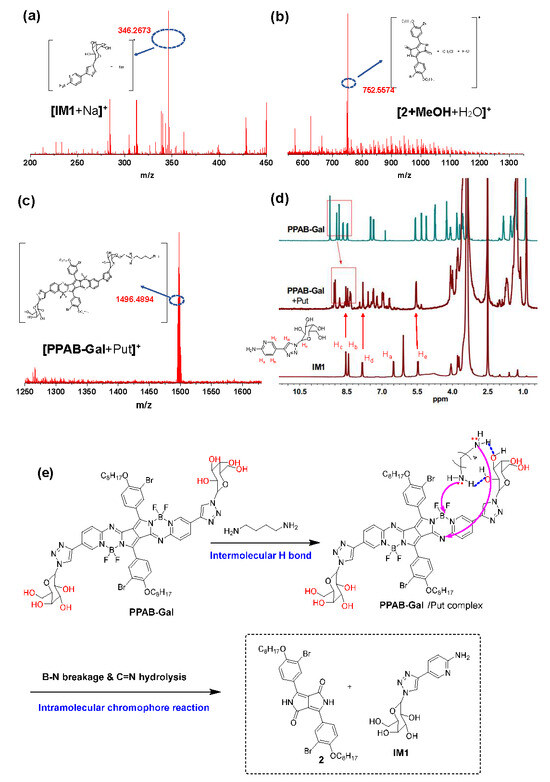
Figure 4.
(a–c) The HRMS spectra of PPAB-Gal in presence of less Put. (d) The 1H NMR spectra of PPAB-Gal in absence and presence of Put, and control compound IM1. (e) The possible sensing mechanism between PPAB-Gal and Put.
To further reveal the sensing mechanism of PPAB-Gal and aromatic BAs, the bond critical point (BCP) of the hydron-bond of interest was analysed [43]. Taking Phe as an aromatic BAs example, the HO…HN hydrogen bond interaction (1.82 Å) represented strong interactions between the galactose moiety of PPAB-Gal and amine group of Phe. Moreover, the weak multiple hydrogen bond interactions with C-H…N (3.33–3.58Å) from phenyl of Phe and N atom of 1,2,3-triazole and strong π…π interaction between phenyl of Phe and 1,2,3-triazole ring of PPAB-Gal were observed (Figure S18a). The BCP value of 0.04381 and 0.00482 for HB and π…π interaction was found. Similarly, the hydron-bond and π…π interaction were also found between PPAB-Gal and His (or Try), as shown in Figure S18b,c. All in all, these noncovalent interactions facilitated to bring aromatic BAs to the proximity of the PPAB-Gal, which was beneficial for chemical reaction based fluorescent probes with improved sensing efficiency. In the same way, the aliphatic BAs would approach PPAB-Gal through H-bonds. Therefore, it is reasonable that PPAB-Gal showed similar reactivity towards aromatic and aliphatic BAs.
Based on discussion mentioned above, the possible reaction mechanism between PPAB-Gal and Put was shown in Figure 4e, confirming the noncovalent interactions facilitated chromophore reaction. Namely, the noncovalent interactions between PPAB-Gal and Put would generate PPAB-Gal/Put complex, following intramolecular chromophore reaction to produce a less conjugated diketopyrrolopyrrole (compound 2) and galactose group functionalized alkynyl aminopyridine (IM1).
3.5. PPAB-Gal-Loaded TLC Plates Toward Put and Cad Vapor
The release of volatile Cad and Put produces bad-tasting food and foul-smelling odor during food spoilage process. The excessive intake can result in hypotension, allergies, headaches, even shock or death [44]. However, volatile amines are generally colorless, which makes their direct visual detection of various amines in environmental samples highly difficult. In order to develop a portable sensing platform for on-site measurement of Put and Cad vapor, TLC plate was immersed in the PPAB-Gal solution and dried in air. After PPAB-Gal-loaded TLC plates were exposed to Cad vapor for 10 min, the images were recorded with a smartphone in different conditions. As shown in Figure 5a, the remarkable color and fluorescence response after exposure to various concentrations of Cad vapors was displayed. A color recognizer APP with RGB (red, green, blue) was utilized to analyse the fluorescence images. The excellent linear relationship (R2 = 0.995) between value of G/(R+B) was and the Cad vapor concentration at 0–1200 ppm was found (Figure 5c). The limit of quantitation detection (LQD) value of 197 ppm was found. Similarly, PPAB-Gal-loaded TLC plates displayed distinct color and emission changes upon exposure of Put vapor, leading to LQD value of 213 ppm (Figure 5b,d).
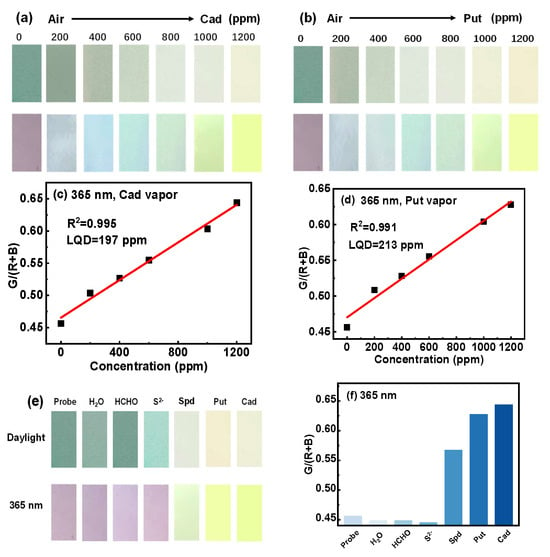
Figure 5.
The photographs of PPAB-Gal-loaded TLC plate in presence of (a) gaseous putrescine, (b) cadaverine and (e) other analytes under daylight and 365 nm irradiation. (c,d,f) The calibration curve of G/(R+B) value extracted from the photos (a,b,e) taken with Color Finder APP, respectively.
The selectivity of the PPAB-Gal-loaded TLC plates to BAs vapor against other gaseous analytes was also investigated. In Figure 5e, obvious color and emission changes after exposure to Spd/Cad/Put vapors were shown, whereas no changes were displayed in the presence of other vapor (H2O, HCHO, H2S). The higher value of G/(R+B) under 365 nm irradiation for Spd/Cad/Put vapors against other analytes indicated PPAB-Gal TLC plates could be used as an ideal and portable sensing platform for selective and visual sensing of BAs vapor (Figure 5f).
3.6. Visually Monitoring the Freshness of Tuna and Shrimp
Due to coexistence of multiple components with similar structure and the complex detection surrounding in food, it is demanding to detect BAs in spoiled food owing to their low concentration and mixtures of multiple amines. Based on superior sensing performance of PPAB-Gal towards 8 BAs, PPAB-Gal-loaded TLC plate was used for in situ monitoring of the freshness of aquatic product (Figure 6a). The visually changes of color and fluorescence photos of the PPAB-Gal-loaded TLC plate with shrimp or tuna at 25 °C were exhibited (Figure 6b). With the prolonging storage time, the emission change from red to yellow and color change from green to light yellow were clearly distinguished. On the contrary, no such obvious changes were found for shrimp or tuna at 4 °C (Figures S19 and S20).
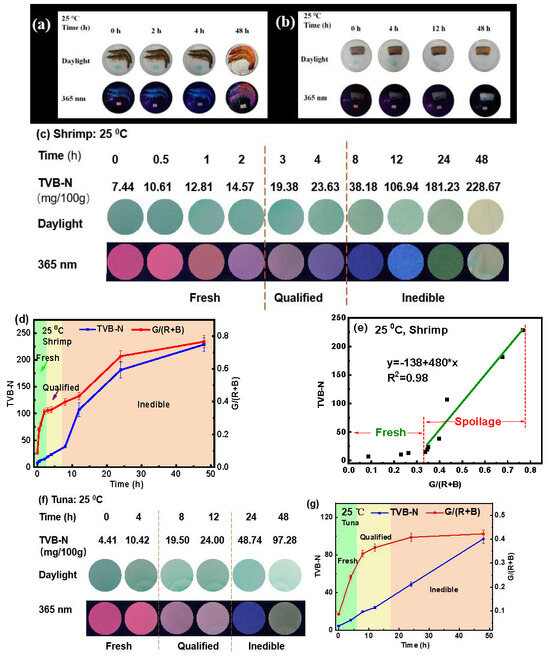
Figure 6.
(a) The design strategy of visual, and non-destructive sensing platform based on PPAB-Gal-loaded TLC plate. (b) The color change and emission of PPAB-Gal-loaded TLC plate for shrimp (a) and tuna (b) at 25 °C, respectively. (c) The relationship between TVBN value and color change for PPAB-Gal-loaded TLC plate for shrimp at 25 °C. The grades of (d,e) shrimp and (f,g) tuna freshness evaluation by measuring TVB-N value using a smartphone sensing platform based on the color of PPAB-Gal-loaded TLC plate under UV light and shrimp samples stored at 25 °C.
Total volatile basic nitrogen (TVBN) value as the comparative method was utilized to predicate the relationship between PPAB-Gal-loaded TLC plate based fluorescence color and sample freshness [45,46,47]. The guidance level of TVBN has been set with ≥20 mg/100 g, 15–20 mg/100 g, ≤15 mg/100 g for spoilage, medium fresh, and freshness, respectively [48]. Figure 6c–e showed the change of TVBN and G/(R+B) value in shrimp after storage for different time at 25 °C. The initial TVB-N value of 7.44 mg/100 g increased to 10.61, 12.81 and 14.57 mg/100 g after 0.5, 1, 2 h storage time, which was identified as fresh. In the meantime, PPAB-Gal TLC plate displayed obvious emission color change from red to purple. It cost 8 h to get spoilage with increased TVBN value of 38.18 mg/100 g. There was strong correlation between TVBN and G/(R+B). The good linear relationship between the G/(R+B) value of PPAB-Gal TLC plate photos and TVBN value in shrimp (R2 = 0.98) was shown. As a result, it’s convenient to evaluate the shrimp spoilage quantitatively with connection between a standard quantitative index of TVBN value and fluorescence signals.
In the case of tuna, similar fluorescence changes and relationship between TVBN and G/(R+B) were found (Figure 6f,g). However, it cost 24 h to get spoilage with increased TVB-N value of 48.74 mg/100 g at 25 °C. These results verified that PPAB-Gal-loaded TLC plate could be utilized as a portable and delicate sensing platform for on-site, non-destructive, convenient and quantitative assessing of aquatic product freshness.
3.7. Visually Monitoring Spermine in Living Cells
PPAB-Gal nanoparticles was fabricated with DSPE-PEG2000 as a wrapping agent to improve its water solubility (Figure 7a). PAB-Gal NPs had NIR absorption band at 600/673 nm and hydrodynamic size of 47 nm through dynamic light scattering (DLS) measurement (Figure 7b,c). The size did not exhibit any changes over 15 days in water, indicative of excellent size stability. Due to presence of galactose group, the excellent biocompability was shown, where the survival rates of Hela cells are larger than 90%.

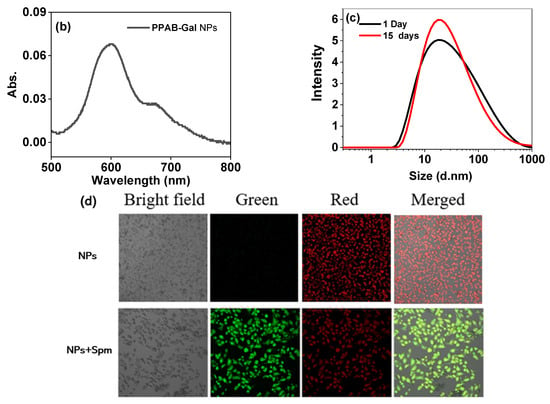
Figure 7.
(a) Preparation of PPAB-Gal NPs. (b) UV-vis and (c) DLS spectra of PPAB-Gal NPs. (d) CLSM images of HeLa cells incubated with PPAB-Gal NPs (50 μM) in absence and presence of spermine (100 μM) (scale bar: 20 μm).
As mentioned above, PPAB-Gal showed high sensitivity to spermine. Since spermine is over-expressed in some cancer cells for assisting cell growth and proliferation, we preliminary investigated whether PPAB-Gal NPs could monitor the presence of endogenous spermine in living cells. As shown in Figure 7d, PPAB-Gal NPs showed red emission by CLSM imaging. Upon addition of spermine, the green emission was clearly presented, yielding the ratiometric emission signal. This can be ascribed to the chemical reaction between PPAB-Gal NPs and spermine to generate the less-conjugated products. These results further demonstrate that PPAB-Gal NPs can detect spermine in living cells by ratiometric CLSM signal.
4. Conclusions
In summary, we successfully developed PPAB-Gal capable of highly efficient detection of eight BAs with significant colorimetric and fluorescence responses by noncovalent interactions enhanced chromophore reaction. The distinctly dual signal changes (Δλab = 130 nm, Δλem = 150 nm), low LOD (down to 25 nM) and fast response time (<2 min) were obtained. The excellent sensing performance enabled PPAB-Gal-loaded TLC plate to act as an efficient platform for gaseous Put and Cad sensing and quantitative assessing of the aquatic product freshness through smartphone-adaptable chromaticity diagram. Moreover, PPAB-Gal NPs could detect spermine in living cells by ratiometric CLSM signal This work provides a portable and delicate on-site platform for quantitatively estimating of food freshness based on a novel strategy for highly sensing eight BAs.
Supplementary Materials
The following supporting information can be downloaded at: https://www.mdpi.com/article/10.3390/bios15080542/s1, Figure S1: 1H NMR spectrum of PPAB-2 in CDCl3; Figure S2: The TOF spectrum of PPAB-2; Figure S3: 1H NMR spectrum of PPAB-OAc in CDCl3; Figure S4: The TOF spectrum of PPAB-OAc; Figure S5: 1H NMR spectrum of PPAB-Gal in DMSO-d6; Figure S6: The TOF spectrum of PPAB-Gal; Figure S7: (a,b) Normalized absorption and emission spectra of PPAB-2, PPAB-OAc, PPAB-Gal in CH2Cl2. Absorption and emission spectra of PPAB-2 (c,d), PPAB-OAc (e,f), PPAB-Gal (g,h) in DMSO/H2O mixture with different fraction of H2O (f,w); Figure S8: Normalized absorption and emission spectra of PPAB-2 (a,b), PPAB-OAc (c,d), and PPAB-Gal (e,f) in different solvents; Figure S9: The DFT results of PPAB-2, PPAB-OAc and PPAB-Gal; Figure S10: The reaction kinetic PPAB-Gal (10 μM) in presence of (a) Spm, (b) Spd, (c) Cad, (d) Put (e) His, (f) Try, (g) Tyr, (h) Phe (200 μM) in DMSO/H2O (4/1, v/v); Figure S11: (a–p) The concentration-dependent UV-vis spectra and linear plot of PPAB-Gal in presence of 8 BAs in DMSO/H2O (4/1, v/v). (q) The LOD values of 8 Bas; Figure S12: (a–p) The concentration-dependent emission spectra and linear plot of PPAB-Gal in presence of 8 BAs in DMSO/H2O (4/1, v/v); Figure S13: Time-dependent of absorption spectra of PPAB-2 (10 μM) in presence of (a) Spm, (b) Spd, (c) Cad, (d) Put, (e) Try, (f) Tyr, (g) Phe and (h) His (200 μM) in DMSO/H2O (4/1, v/v); Figure S14: Time-dependent of UV-vis absorption spectra of PPAB-OAc (10 μM) in presence of (a) Spm, (b) Spd, (c) Cad, (d) Put (e) Try, (f) Tyr, (g) Phe, and (h) His (200 μM) in DMSO/H2O (4/1, v/v); Figure S15: (a) The reaction kinetics curves of PPAB-Gal towards 8 BAs. (b) The electrostatic surface potential (ESP) maps of PPAB-2, PPAB-OAc, and PPAB-Gal; Figure S16: The FT-IR spectra of PPAB-Gal in presence of Put; Figure S17: The DFT results of PPAB-Gal and possible products (compounds 2 and IM1); Figure S18: Optimized molecular structure (gaseous state) of PPAB-Gal and Phe, Try and His with selected interatomic distances (Å); Figure S19: (a,b) The color change and emission of PPAB-Gal -loaded TLC plate for shrimp at 4 °C. (c) The grades of shrimp freshness evaluation by measuring TVB-N value using a smartphone sensing platform based on the color of PPAB-Gal -loaded TLC plate under UV light at 4 °C; Figure S20: (a,b) The photos of color change and emission of PPAB-Gal -loaded TLC plate for tuna at 4 °C. (c) The grades of tuna freshness evaluation by measuring TVB-N value using a smartphone sensing platform based on the color of PPAB-Gal-loaded TLC plate under UV light at 4 °C. Table S1:The photophysical data of PPAB-2, PPAB-OAc and PPAB-Gal in different solvents; Table S2: The comparison of fluorescent probes for BAs detection in food. Table S3: Summary of different BAs detection methods.
Author Contributions
Conceptualization, X.R. and L.W.; Methodology, Y.G., B.L. and J.Z.; Software, J.Z.; Validation, Y.G., B.L. and J.Z.; Formal analysis, Y.G. and B.L.; Investigation, Y.G., B.L. and D.C.; Resources, X.R. and L.W.; Data curation, Y.G. and B.L.; Writing–original draft, X.R. and L.W.; Writing–review & editing, X.R., D.C. and L.W.; Visualization, X.R. and D.C.; Supervision, L.W.; Project administration, L.W.; Funding acquisition, L.W. All authors have read and agreed to the published version of the manuscript.
Funding
This research received no external funding.
Data Availability Statement
Data contained within the article or Supplementary Materials.
Acknowledgments
We are grateful to the National Natural Science Foundation of China (22071065) and Guangdong Basic and Applied Basic Research Foundation (2022A1515011743, 2024A1515012774).
Conflicts of Interest
The authors declare no conflict of interest.
References
- Liu, H.; Wang, R.; Zhao, D.; Liang, D.; Zhang, C.; Jiao, Y.; Xiao, X.J. Preparation of Fe, Co, P-Codoping Peroxidase-like Green-Emitting Carbon Dots and Its Application in Monitoring the Freshness of Aquatic Products. Agric. Food Chem. 2024, 72, 22883–22892. [Google Scholar] [CrossRef]
- Sun, Y.; Zhang, W.; Lu, S.; Miao, W.; Chen, M.; Liu, F.; Na, H.; Zhu, J. Cellulose-based fluorescent materials fabricated in CO2 switchable solvent for freshness monitoring. Carbohydr. Polym. 2023, 301, 120346. [Google Scholar] [CrossRef]
- Martin, N.H.; Torres-Frenzel, P.; Wiedmann, M. Invited review: Controlling dairy product spoilage to reduce food loss and waste. J. Dairy Sci. 2021, 104, 1251–1261. [Google Scholar] [CrossRef]
- Koo, P.-L.; Lim, G.-K. A review on analytical techniques for quantitative detection of histamine in fish products. Microchem. J. 2023, 189, 108499. [Google Scholar] [CrossRef]
- Harmoko, H.; Kartasasmita, R.E.; Munawar, H.; Rakhmawati, A.; Budiawan, B. Determination of histamine in different compositions of commercially canned fish in Indonesia by modified QuEChERS and LC-MS/MS. J. Food Compos. Anal. 2022, 105, 104256. [Google Scholar] [CrossRef]
- Altieri, I.; Semeraro, A.; Scalise, F.; Calderari, I.; Stacchini, P. European official control of food: Determination of histamine in fish products by a HPLC–UV-DAD method. Food Chem. 2016, 211, 694–699. [Google Scholar] [CrossRef] [PubMed]
- De Abreu, I.R.; Barkdull, A.; Munoz, J.R.; Smith, R.P.; Craddock, T.J.A. A molecular analysis of substituted phenylethylamines as potential microtubule targeting agents through in silico methods and in vitro microtubule-polymerization activity. Sci. Rep. 2023, 13, 14406. [Google Scholar] [CrossRef] [PubMed]
- Hernández-Orte, P.; Lapeña, A.C.; Peña-Gallego, A.; Astrain, J.; Baron, C.; Pardo, I.; Polo, L.; Ferrer, S.; Cacho, J.; Ferreira, V. Biogenic amine determination in wine fermented in oak barrels: Factors affecting formation. Food Res. Int. 2008, 41, 697–706. [Google Scholar] [CrossRef]
- Song, L.; Huang, Y.; Gou, M.; Crommen, J.; Jiang, Z.; Feng, Y. Method development and validation for the determination of biogenic amines in soy sauce using supercritical fluid chromatography coupled with single quadrupole mass spectrometry. J. Sep. Sci. 2020, 43, 2728–2736. [Google Scholar] [CrossRef]
- Feng, C.; Teuber, S.; Gershwin, M.E. Histamine (Scombroid) Fish Poisoning: A Comprehensive Review. Clin. Rev. Allergy Immunol. 2016, 50, 64–69. [Google Scholar] [CrossRef]
- Del Rio, B.; Redruello, B.; Linares, D.M.; Ladero, V.; Fernandez, M.; Martin, M.C.; Ruas-Madiedo, P.; Alvarez, M.A. The dietary biogenic amines tyramine and histamine show synergistic toxicity towards intestinal cells in culture. Food Chem. 2017, 218, 249–255. [Google Scholar] [CrossRef]
- Rocha, S.M.; Saraiva, T.; Cristóvão, A.C.; Ferreira, R.; Santos, T.; Esteves, M.; Saraiva, C.; Je, G.; Cortes, L.; Valero, J.; et al. Histamine induces microglia activation and dopaminergic neuronal toxicity via H1 receptor activation. Neuroinflammation 2016, 13, 137. [Google Scholar] [CrossRef] [PubMed]
- Goto, A.; Mouri, A.; Nagai, T.; Yoshimi, A.; Ukigai, M.; Tsubai, T.; Hida, H.; Ozaki, N.; Noda, Y. Involvement of the histamine H4 receptor in clozapine-induced hematopoietic toxicity: Vulnerability under granulocytic differentiation of HL-60 cells. Toxicol. Appl. Pharmacol. 2016, 306, 8–16. [Google Scholar] [CrossRef] [PubMed]
- Serrano, V.M.; Cardoso, A.R.; Diniz, M.; Sales, M.G.; Sales, G.F. In-situ production of histamine-imprinted polymeric materials for electrochemical monitoring of fish. Sens. Actuators B 2020, 311, 127902. [Google Scholar] [CrossRef]
- Wang, Q.-H.; Fang, G.-Z.; Liu, Y.-Y.; Zhang, D.-D.; Liu, J.-M.; Wang, S. Fluorescent Sensing Probe for the Sensitive Detection of Histamine Based on Molecular Imprinting Ionic Liquid-Modified Quantum Dots. Food Anal. Methods 2017, 10, 2585–2592. [Google Scholar] [CrossRef]
- Müller, D.G.; Oreste, E.; Heinemann, M.; Dias, D.; Kessler, F. Biogenic amine sensors and its building materials: A review. Eur. Polym. J. 2022, 175, 111221. [Google Scholar] [CrossRef]
- Casero, R.A., Jr.; Marton, L.J. Targeting polyamine metabolism and function in cancer and other hyperproliferative diseases. Nat. Rev. Drug Discov. 2007, 6, 373–390. [Google Scholar] [CrossRef]
- Wang, L.; Ran, X.; Tang, H.; Cao, D. Recent advances on reaction-based amine fluorescent probes. Dyes Pigments 2021, 194, 109634. [Google Scholar] [CrossRef]
- Dhara, S.R.; Saha, R.; Baildya, N.; Acharya, K.; Bhattacharya, A.; Ghosh, K. New Cyanostyrylcopillar [5]arene Derivative: Synthesis, Photophysical Study, Chromogenic Detection of Aliphatic Amines, and Biofilm–Antibiofilm Activity. ACS Appl. Mater. Interfaces 2024, 16, 7275–7287. [Google Scholar] [CrossRef]
- Bao, C.; Shao, S.; Zhou, H.; Han, Y. A new ESIPT-based fluorescent probe for the highly sensitive detection of amine vapors. New J. Chem. 2021, 45, 10735–10740. [Google Scholar] [CrossRef]
- Mallick, S.; Chandra, F.; Koner, A.L. A ratiometric fluorescent probe for detection of biogenic primary amines with nanomolar sensitivity. Analyst 2016, 141, 827–831. [Google Scholar] [CrossRef]
- Zhang, J.; Yang, Y.; Zeng, L.; Wang, J. A ratiometric fluorescence platform for on-site screening meat freshness. Food Chem. 2024, 436, 137769. [Google Scholar] [CrossRef]
- Chakraborty, M.; Sivasakthi, P.; Samanta, P.; Chakravarty, M.J. Concentration-tuned diverse response to selective biogenic amines using a reusable fluorophore: Monitoring protein-rich food spoilage. Mater. Chem. B 2024, 12, 2746–2760. [Google Scholar] [CrossRef]
- Unabia, R.B.; Reazo, R.L.D.; Rivera, R.B.P.; Lapening, M.A.; Omping, J.L.; Lumod, R.M.; Ruda, A.G.; Sayson, N.L.B.; Dumancas, G.; Malaluan, R.M.; et al. Dopamine-Functionalized Gold Nanoparticles for Colorimetric Detection of Histamine. ACS Omega 2024, 9, 17238–17246. [Google Scholar] [CrossRef] [PubMed]
- Gu, Y.; Liu, L.; Wang, Y.; Zhang, C.; Satoh, T. Chromaticity sensor for discriminatory identification of aliphatic and aromatic primary amines based on conformational changes of polyacetylene. Talanta 2024, 268, 125361. [Google Scholar] [CrossRef] [PubMed]
- Danchuk, A.I.; Komova, N.S.; Mobarez, S.N.; Doronin, S.Y.; Burmistrova, N.A.; Markin, A.V.; Duerkop, A. Optical sensors for determination of biogenic amines in food. Anal. Bioanal. Chem. 2020, 412, 4023–4036. [Google Scholar] [CrossRef] [PubMed]
- Wu, G.; Dou, X.; Li, D.; Xu, S.; Zhang, J.; Ding, Z.; Xie, J. Recent Progress of Fluorescence Sensors for Histamine in Foods. Biosensors 2022, 12, 161. [Google Scholar] [CrossRef]
- Leelasree, T.; Dixit, M.; Aggarwal, H. Cobalt-Based Metal–Organic Frameworks and Its Mixed-Matrix Membranes for Discriminative Sensing of Amines and On-Site Detection of Ammonia. Chem. Mater. 2023, 35, 416–423. [Google Scholar] [CrossRef]
- Li, L.; Ma, Y.; Yang, H.; Niu, J.; Yang, H.; Wang, F.; Hu, C.; Zhang, Y.; Guan, X.; Peng, H.; et al. An Olefin-based, Fluorescent Covalent Organic Framework for Selective Sensing of Aromatic Amines. Chem. Asian J. 2022, 17, e202200279. [Google Scholar] [CrossRef]
- Li, L.; Li, W.; Ran, X.; Wang, L.; Tang, H.; Cao, D. A highly efficient, colorimetric and fluorescent probe for recognition of aliphatic primary amines based on a unique cascade chromophore reaction. Chem. Commun. 2019, 55, 9789–9792. [Google Scholar] [CrossRef]
- Li, L.; Li, W.; Wang, L.; Tang, H.; Cao, D.; Ran, X. Pyrrolopyrrole aza-BODIPY dyes for ultrasensitive and highly selective biogenic diamine detection. Sens. Actuators B Chem. 2020, 312, 127953. [Google Scholar] [CrossRef]
- Li, W.; Wang, L.; Sun, T.; Tang, H.; Bui, B.; Cao, D.; Wang, R.; Chen, W. Characterization of nanoparticles combining polyamine detection with photodynamic therapy. Commun. Biol. 2021, 4, 803. [Google Scholar] [CrossRef] [PubMed]
- Li, W.; Wang, L.; Zhang, C.; Ran, X.; Tang, H.; Cao, D.J. Novel butterfly-shaped AIE-active pyrrolopyrrole aza-BODIPYs: Synthesis, bioimaging and diamine/polyamine detection. Mater. Chem. C 2022, 10, 5672–5683. [Google Scholar] [CrossRef]
- Wang, L.; Gan, Y.; Ran, X.; Cao, D. Simultaneous sensing cyanide and fluoride by Lewis acidic atom regulated–chromophore reaction and applications in real samples. Microchem. J. 2024, 207, 111832. [Google Scholar] [CrossRef]
- Percec, V.; Leowanawat, P.; Sun, H.-J.; Kulikov, O.; Nusbaum, C.D.; Tran, T.M.; Bertin, A.; Wilson, D.A.; Peterca, M.; Zhang, S.; et al. Modular Synthesis of Amphiphilic Janus Glycodendrimers and Their Self-Assembly into Glycodendrimersomes and Other Complex Architectures with Bioactivity to Biomedically Relevant Lectins. Am. Chem. Soc. 2013, 135, 9055–9077. [Google Scholar] [CrossRef]
- Xu, S.; Liu, H.-W.; Huan, S.-Y.; Yuan, L.; Zhang, X.-B. Recent progress in utilizing near-infrared J-aggregates for imaging and cancer therapy. Mater. Chem. Front. 2021, 5, 1076–1089. [Google Scholar] [CrossRef]
- GB 5009.228-2016; National Food Safety Standard—Determination of Volatile Base Nitrogen in Foods. National Health and Family Planning Commission of the People’s Republic of China Publishing: Beijing, China, 2016.
- Han, X.-J.; Yan, Y.-J.; Dou, L.; Peng, Y.-D.; Huang, F.; Dong, W.-K. The investigation on first Co(III) pyridine-including half-salamo-like complexes. J. Mol. Struct. 2022, 1265, 133475. [Google Scholar] [CrossRef]
- Mattsson, L.; Xu, J.; Preininger, C.; Tse Sum Bui, B.; Haupt, K. Competitive fluorescent pseudo-immunoassay exploiting molecularly imprinted polymers for the detection of biogenic amines in fish matrix. Talanta 2018, 181, 190–196. [Google Scholar] [CrossRef]
- Yadav, A.; Upadhyay, Y.; Bera, R.K.; Sahoo, S.K. Vitamin B6 cofactors guided highly selective fluorescent turn-on sensing of histamine using beta-cyclodextrin stabilized ZnO quantum dots. Food Chem. 2020, 320, 126611. [Google Scholar] [CrossRef]
- Stiufiuc, R.; Iacovita, C.; Nicoara, R.; Stiufiuc, G.; Florea, A.; Achim, M.; Lucaciu, C.M. One-Step Synthesis of PEGylated Gold Nanoparticles with Tunable Surface Charge. J. Nanomater. 2013, 2013, 146031. [Google Scholar] [CrossRef]
- Emamian, S.; Lu, T.; Kruse, H.; Emamian, H. Exploring Nature and Predicting Strength of Hydrogen Bonds: A Correlation Analysis Between Atoms-in-Molecules Descriptors, Binding Energies, and Energy Components of Symmetry-Adapted Perturbation Theory. J. Comput. Chem. 2019, 40, 2868–2881. [Google Scholar] [CrossRef]
- Zhang, J.; Yue, C.; Ke, Y.; Qu, H.; Zeng, L. Fluorescent probes for the detection of biogenic amines, nitrite and sulfite in food: Progress, challenges and perspective. Adv. Agrochem 2023, 2, 127–141. [Google Scholar] [CrossRef]
- Prabhakar, P.K.; Vatsa, S.; Srivastav, P.P.; Pathak, S.S. A comprehensive review on freshness of fish and assessment: Analytical methods and recent innovations. Food Res. Int. 2020, 133, 109157. [Google Scholar] [CrossRef] [PubMed]
- Miao, X.; Wu, C.; Li, F.; Zhang, M. Fast and Visual Detection of Biogenic Amines and Food Freshness Based on ICT-Induced Ratiometric Fluorescent Probes. Adv. Funct. Mater. 2023, 33, 2212980. [Google Scholar] [CrossRef]
- Jiang, L.; Zhu, B.; Shao, Y.; Ye, H.; Hu, X.; Min, D. High-performance fluorescence platform for real-time non-destructive and visual screening of meat freshness. Dyes Pigments 2023, 220, 111771. [Google Scholar] [CrossRef]
- Guo, L.; Wang, T.; Wu, Z.; Wang, J.; Wang, M.; Cui, Z.; Ji, S.; Cai, J.; Xu, C.; Chen, X. Portable Food-Freshness Prediction Platform Based on Colorimetric Barcode Combinatorics and Deep Convolutional Neural Networks. Adv. Mater. 2020, 32, 2004805. [Google Scholar] [CrossRef]
- Wang, J.-Y.; Chen, L.-J.; Zhao, X.; Yan, X.-P. Silk fibroin-based colorimetric microneedle patch for rapid detection of spoilage in packaged salmon samples. Food Chem. 2023, 406, 135039. [Google Scholar] [CrossRef]
Disclaimer/Publisher’s Note: The statements, opinions and data contained in all publications are solely those of the individual author(s) and contributor(s) and not of MDPI and/or the editor(s). MDPI and/or the editor(s) disclaim responsibility for any injury to people or property resulting from any ideas, methods, instructions or products referred to in the content. |
© 2025 by the authors. Licensee MDPI, Basel, Switzerland. This article is an open access article distributed under the terms and conditions of the Creative Commons Attribution (CC BY) license (https://creativecommons.org/licenses/by/4.0/).